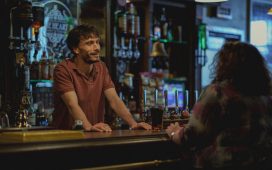In the series, fellow orphan-turned-older sister figure Jolene (Moses Ingram) slyly advises Beth to wait and take the green ones right before bed, “otherwise they turn off right when you need them to turn on.” For Beth, that means that they put her in an altered state; once she is introduced to a chessboard, the pills allow her to hallucinate the pieces on her bedroom ceiling, mapping out moves late into the night.
While Beth’s reactions to the sedatives initially seem quaint, it soon becomes clear that the child has gotten hooked. Soon after her arrival, the orphanage stops administering the green “vitamins” after they are banned for their habit-forming tendencies—but by then Beth is experiencing withdrawal symptoms. Her desperate attempt to break into the orphanage’s pharmacy at the end of the first episode sets the series’ tone for gripping cinematography, with the shot of Beth collapsed among the scattered pills she so craves.
This stage of Beth’s life also has stakes in reality: A 2018 BuzzFeed investigation into the Catholic orphanage system in 20th century North America found evidence and accounts of nuns-turned-nurses administering intravenous sedatives to orphans.
After that stunt, the pills leave Beth’s life for years; she may never have encountered them again if it weren’t for her stepmother, Alma Wheatley (Marielle Heller), and her need for “tranquility medicine” to ease the pain of her unfulfilled artist dreams: She has Beth refill a prescription for none other than familiar green Xanzolam, which helps “even out” both mother and daughter in different ways.
While the name Xanzolam is fictional, the pill is clearly intended to be a stand-in for real-life benzodiazepines, tranquilizer drugs that act on the brain and central nervous system in order to reduce anxiety, soothe insomnia, and (ironically) treat withdrawal symptoms. Intended as a safer alternative to barbiturates, “benzos” were often abused by being taken far beyond the recommended short-term period of treatment. Developed in the 1950s, benzos were a fixture in society by the 1960s, with doctors regularly prescribing “Mother’s Little Helper” as a quick fix for housewives’ ennui.














